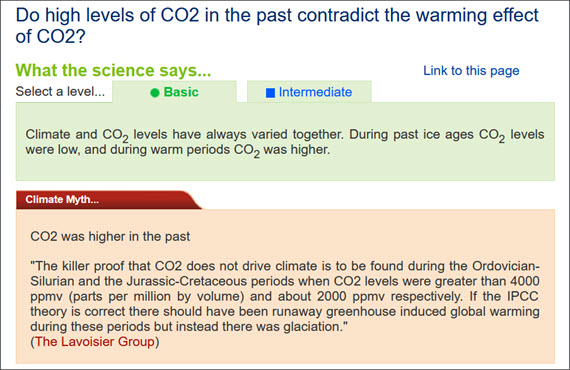
On February 14, 2023 we announced our Rebuttal Update Project. This included an ask for feedback about the added "At a glance" section in the updated basic rebuttal versions. This weekly blog post series highlights this new section of one of the updated basic rebuttal versions and serves as a "bump" for our ask. This week features "Do high levels of CO2 in the past contradict the warming effect of CO2?". More will follow in the upcoming weeks. Please follow the Further Reading link at the bottom to read the full rebuttal and to join the discussion in the comment thread there.
Before diving headlong into this myth, one key thing needs to be pointed out. The confidence expressed in the above statement. Phrases like 'killer proof' should be enough to ring alarm bells warning the statement is not the work of any credible scientist. Scientific writing is a relatively sober business.
That aside, this myth is about the nature of Earth's atmosphere and climate through deep time. We know quite a bit about that atmosphere now - but far from everything. Through geological studies, we know a lot more about how the planetary climate evolved over time. But far from everything. It's work in progress.
Evolution of climate over deep time was governed by several factors. Fluctuations in the carbon cycle were driven by changes in the balance between CO2 sources and sinks. In those pre-human times, the key CO2 source was volcanic and the key sink was, as now, weathering. Volcanism is still a significant CO2 source - but about a hundredfold less than human emissions.
Weathering is a chemical reaction that involves the breakdown of the minerals making up the rocks of Earth's surface. Its key agent is carbon dioxide dissolved in rainwater, this being a weak acid. Since rainwater delivers the CO2, the intensity of weathering will partly depend upon rainfall. In turn, that depends on how wet - or dry - the climate happens to be in any given place at any given time.
That leads us into palaeogeography - the science of how the layout of the globe has changed through time. Slow changes in layout are driven by plate tectonics and continental drift. Geological evidence tells us that most of the continents on Earth were sometimes gathered together, to form 'supercontinents'. At other times, they were widely dispersed. Such changes in layout through deep time had implications for both the climate and intensity of weathering.
In general terms, the dry interior of a supercontinent reduces weathering, allowing CO2 levels to rise because the sink cannot keep up with the source. A dispersed pattern is a lot better for weathering and the sink can outpace the source, allowing CO2 levels to fall.
Over geological timescales, changes in Solar brightness matter, too. Solar brightness is considered to have increased steadily by about 10% per billion years of Earth's history. In the late Ordovician, 445 million years ago, there would therefore have been 4-5% less sunshine reaching the Earth. That's a big difference and enough to change what is known as the 'ice-threshold' - the point beyond which perennial ice-sheets can exist on Earth's surface.
There was certainly an ice-age in the late Ordovician. There are multiple lines of evidence that lend support to that statement. Dispersed continents favoured weathering and CO2 drawdown. Because of the dimmer Sun, the ice-threshold was set at a much higher CO2 level than in more recent times. Something else happened too. The late Ordovician ice-age was accompanied by the second-greatest mass-extinction in the fossil record. Neither the quote nor its parent document mention that. One wonders why.
Please use this form to provide feedback about this new "At a glance" section. Read a more technical version below or dig deeper via the tabs above!
In case you'd like to explore more of our recently updated rebuttals, here are the links to all of them:
Posted by John Mason on Tuesday, 17 October, 2023
 |
The Skeptical Science website by Skeptical Science is licensed under a Creative Commons Attribution 3.0 Unported License. |